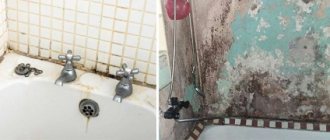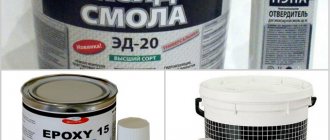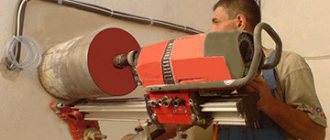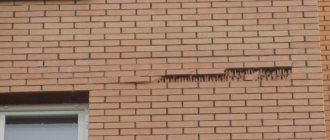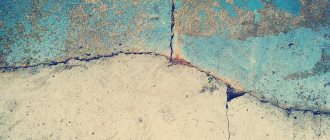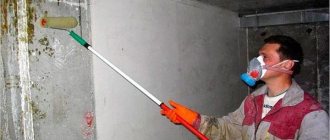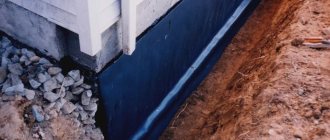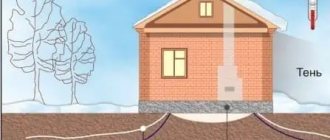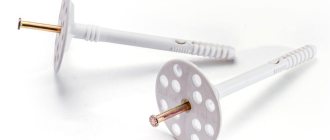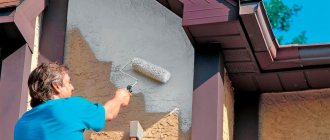Universal Cleaner
Moss and mold cleaner for walls, floors and roofs (concentrate)
Read more
Many types of mold are very harmful to humans because they produce dangerous toxins. As a result, people who live in contaminated premises may develop conditions such as:
- allergy;
- asthma;
- migraine;
- rheumatism.
People with weakened immune systems, as well as children and the elderly are especially vulnerable to harmful effects.
Mold, as well as mosses and lichens, harm not only human health, but also building materials, destroying wood, concrete, and ceramic products.
How does mold appear on concrete?
Concrete looks like a dense material from the outside, but, unlike, for example, glass, it has a porous structure.
Concrete is made on the basis of a water-hardening binder (cement), that is, to obtain it, cement is mixed with water (and small and large aggregates are also added).
There are always air bubbles in the concrete mixture. Vibration treatment of the concrete mixture after placing it in the mold is carried out in order to lay the solution more densely and expel excess air, but a certain amount of air still remains in the mixture.
As a result, when concrete hardens, a network of capillaries remains in it, as well as pores of various diameters.
Important!
The use of plasticizing additives, for example, Cemmix plasticizers, as well as water repellents, significantly reduces the number and diameter of pores in concrete, making it possible to obtain a more dense material. The increased density of concrete directly affects its strength, water-repellent properties and frost resistance.
There are always pores and capillaries in ready-made concrete. If volumetric hydrophobization was carried out (the use of water-repellent additives in the solution), or plasticizers were used, there will be fewer pores, but they will still exist. When using the product in conditions of high humidity, water will penetrate into the pores and capillaries, creating conditions for the appearance of mold, lichens, and mosses.
Why does mold appear on concrete?
Mold may appear on concrete in the following cases:
- rooms with high humidity (bathrooms, showers, kitchens);
- rooms with poor ventilation;
- water supply or sewerage leaks;
- improper insulation, which leads to freezing of corners and the formation of condensation;
- roof leaks;
- rise of moisture from the soil along the foundation to the walls;
- poor basement waterproofing.
Important!
Water can rise through a capillary network in concrete to a height of up to 2 m.
Antiseptic for concrete against mold: how to treat it
Building structures based on mineral binders (cement, gypsum) - concrete, mortars and plasters - are characterized by the presence of small air pores in their volume, into which moisture and mold spores can enter.
The waste product of mold is the release of solutions of acids and alkalis, which gradually dissolve cement stone and gypsum compounds. A sign of the presence of mold are spots of black, blue and green, and a sign of structural destruction is swelling and peeling. Often the food medium for the development of mold is salts dissolved in water, which entered the structure with moisture from the environment.
During new construction and reconstruction, to combat the causes of mold, the following measures must be taken:
- Construct foundation structures from concrete with increased water resistance. For this purpose, a water-repellent concrete additive CEMMIX CemAqua is used - it provides volumetric water-repellency, reduces water absorption, and prevents the appearance of efflorescence and mold.
- External structures must be vapor-permeable, but treated with a water-repellent composition CEMMIX CemAquaStop - a product for treating the surface of building structures to prevent the appearance of fungi and mold. - Installation of reliable waterproofing of all building structures from the foundation to the roof, in all wet rooms, on balconies, loggias, terraces. Prevent the penetration of moisture through seams and junctions, including in places where various communications pass (water supply, sewerage, electricity, heating mains, etc.)
- Provide normal heating, ventilation and air conditioning (in accordance with current building codes SP60.13330.2012 “Heating, ventilation and air conditioning”).
- If mold appears on the surface of building structures, then it is necessary to take measures to destroy the mold that has appeared and clean the structures with special compounds. To do this, chemical fungal cleaning agents (fungicides or antiseptics) are used. We recommend using CEMMIX Biocid - this is a concentrate that is used for prevention and also for the destruction of mold on affected surfaces. CEMMIX Biocid also protects against damage by fungus, algae, moss, and is effective indoors and outdoors.
Work on treating the affected areas is carried out several times, depending on the degree of damage, until the mold is completely destroyed. When performing this work, you must follow the manufacturer's instructions.
Mold fungi quickly cover the surface of concrete in the event of moisture condensation. As practice shows, any living space with insufficient ventilation can be attacked by mold.
Considering that mold spores are causative agents of respiratory tract diseases, it is customary to coat concrete structures with special antiseptic compounds even before finishing or after cleaning from mold that has appeared.
- Water-soluble antiseptics. Due to the fact that their composition contains mineral salts that are aggressive to steel reinforcement, they have a narrow scope of application. They have good adhesion. A popular dry water-soluble antiseptic that reliably protects concrete and plaster from harmful biological factors is “Gambit”, the properties of which correspond to the “strongest” combined materials;
- Antiseptics based on organic solvent. They are an effective option for impregnating mold against any substrate: concrete, artificial stone, brick and ceramic tiles. These are toxic substances, the use of which requires the use of Personal Protective Equipment. They do not destroy steel reinforcement, effectively destroy fungi and retain their properties for several years. One of the most popular “representatives” of organic solvent antiseptics is the “Nortex” disinfector;
- Combined. They are produced using complex technology from several “ingredients”. They are sold in the form of concentrated solutions that are diluted with water in one proportion or another. The most popular combined antiseptic for concrete can be called the material “Ceresit CT-99”. This antiseptic can be applied both to a concrete base and to plastered or painted walls. “Ceresit CT-99” not only kills mold fungi, bacteria, moss and lichen, but also does not allow their spores to germinate (the longest protection).
Almost any antiseptic for concrete against mold is toxic and dangerous to human health. Therefore, when applied to the surface, the skin, mucous membrane and eyes should be reliably protected with special personal protective equipment. After work, the premises are thoroughly ventilated.
If the surface of the concrete is already affected by mold, no, even the most powerful antiseptic will help. In this case, a set of measures is necessary:
- Determining the causes of mold;
- Thorough removal of fungal plaque by mechanical means;
- Thorough drying of the surface;
- Antiseptic treatment;
- Surface treatment with a water-repellent composition “on concrete”.
In this case, the antiseptic should be applied not only to the infected part of the surface. It is best to treat all rooms with the composition. After all, sooner or later, fungal spores will resume their activity and “populate” another suitable place in the room, kitchen, corridor or hallway with mold.
Ways to prevent re-injury:
- Regularity of treatment, regardless of the type and “power” of the antiseptic;
- In rooms with high humidity, treatment with an antiseptic is carried out at the first signs of mold;
- In heated, dry rooms, one treatment is sufficient;
- In unheated rooms, the frequency of treatment is once every 15 years;
- Building facades require treatment every 7-8 years;
- Sienas of buildings protected by ventilated curtain facades - once every 30 years.
In this case, disinfectant compounds can be added to plaster, cement and concrete mortar at the mixing stage. In general, the antiseptic consumption is 6 kilograms of material per 10 m3 of concrete, cement or plaster mortar. In addition, it is necessary to ensure effective ventilation of the premises and, if possible, to prevent excessive waterlogging with water and water vapor.
Mold and mildew actively spread in rooms with very high air humidity. You can purchase a hygrometer, a special device that measures the level of moisture in the air. By the way, it is present in some models of wall clocks. Normal humidity is from 30% to 60%. If the room is damp, the humidity is higher than normal, then ventilation is necessary, and this should be done regularly.
Fans and air conditioners can also help combat this problem. For warehouses, a ventilation system is installed. If sealed plastic windows are installed in the room, they may interfere with quality ventilation. To correct the situation, it is worth installing ventilation valves on each window.
It is also not recommended to place furniture close to walls that have wallpaper, so as not to create a favorable environment for the development of mold.
Mold can form on the walls if the roof leaks or when water from the apartment above gets on them. Here you need to be careful and prevent undesirable consequences in time. But what to do if mold and mildew have already appeared? Here you should determine the type of walls, and then follow the instructions.
Before work, be sure to protect your respiratory tract: wear a mask or respirator so that the fungus does not damage your health. Next, remove the wallpaper if it is pasted. They will have to be thrown away because the fungus cannot be washed off of them.
Using a spatula, you will need to clean out the areas where mold has formed. If there is loose black plaster, it will need to be completely removed. Once this is done, take sandpaper and gently but vigorously sand the affected areas. Afterwards you will need a special fungicidal solution to treat the wall.
We suggest you familiarize yourself with the blind area around the house - how to do it correctly. The best blind areas for modern types of houses (145 photos)
This will need to be repeated five hours after the previous treatment. Next, prime the walls with an antiseptic solution. Afterwards you can plaster them and glue new wallpaper. This process needs to be treated with special attention, because it is the incorrect treatment of the walls before wallpapering that can cause the appearance of fungus.
Brick walls
Treatment with special chemicals is suitable here: copper sulfate, alkali, lime. In some cases, household products such as laundry detergent or weed remover can also help.
Also, fungus is removed from brick walls using industrial 70 percent hydrogen peroxide.
Before you start cleaning the walls, you must put on a respirator. Next, clean the surface using a spatula, as described in the instructions for concrete walls.
If you choose alkali, then be extremely careful, because it is caustic and a very dangerous substance.
Wooden walls
First, you will need to clean off the infected areas with a wire brush or a well-sharpened knife. The wood will need to be rinsed well afterwards with detergent. It would be better to burn all cleaned wood with fungus. Afterwards, it is necessary to treat the wooden surface with chemical solutions or ordinary pharmacy peroxide (apply a 3 - 5 percent solution to the walls for about 10 minutes, and then wipe with a rag soaked in water). You can also coat the wood with vinegar after cleaning. If you decide to choose a chemical, seek advice from a specialist first.
Drywall
Be sure to wear a respirator and gloves before removing mold and mildew. It is also advisable to wear special glasses to protect your eyes. It is also better to protect curtains, carpets, furniture by covering it all with fabric or bags.
First, clean the wooden surfaces that are attached to the drywall. This way you will remove visible fungus and mold. Next, you can use the following recipe: add 2 tablespoons of dishwashing gel to a bucket of clean water, then soak a rag in the resulting solution and rinse the previously cleaned surface, and then wipe with a dry rag or towel.
Porous structure of concrete
Why is mold on concrete dangerous?
The appearance of mold always means damage to property. Mold does not look aesthetically pleasing, spoils the appearance of the room, and renders wallpaper, plaster and other finishing materials, as well as furniture, unusable.
Developing in the pores and capillaries of concrete, mold fungi release products of their metabolism, which contain organic acids. Since concrete has alkaline components, it enters into chemical neutralization reactions with acids to form salts. In the process of these reactions, the compounds of the concrete itself are consumed, which inevitably causes destruction of its structure with the simultaneous appearance of efflorescence.
As mold grows, it releases more acids, and the destruction of concrete progresses. In a short time it can be severely destroyed (to a depth of up to 2 cm per year).
Concrete protection measures, such as the use of impregnations, help prevent mold; If carried out in a timely manner, they are quite effective, but over time this protection may also weaken.
Causes of mold and methods for preventing it
The main reason for the occurrence of harmful microorganisms in concrete is the penetration of moisture into its porous structure. If excess water does not have the opportunity to evaporate, conditions are formed that promote the growth of mold and various fungi. At the same time, painting the surface to remove external defects is strongly not recommended, because spores can penetrate the human respiratory system, leading to allergies, asthma and other diseases.
It is best to prevent the possibility of mold occurring at the initial stage of construction. For this purpose, special waterproofing materials are used to prevent spores from penetrating into the structure of the structure. It should be noted that this method is characterized by increased efficiency, protecting the structure for several decades.
Another effective method is to treat the surface with special antifungal primers. Such substances penetrate the pores of the concrete structure, creating a protective film and sealing even micro-holes. It is advisable to use such work not only at the early stage of construction, but also during cosmetic repairs, because over time the protection loses its properties.
What to do with mold on concrete: clean it or leave it?
It is clear that leaving mold in place is a bad idea, since the fungus will grow and continue its destructive work until it renders the structure completely unusable. All this time he will damage property and harm people's health.
Therefore, as soon as mold is noticed, it is necessary to take measures to get rid of it.
Interesting!
In the old days, wooden houses infected with mold were simply burned, because once the mold appeared, it did not disappear. In those days there were no effective antiseptics.
We don’t need to burn the house down because of mold, but we should be well aware that simple mechanical cleaning will not help here: spores remain, and under favorable conditions the fungus will germinate again.
Therefore, mechanical cleaning must be combined with the use of antifungal agents. At home, use the following options:
- a weak solution of baking soda;
- vinegar;
- chlorine bleach “Whiteness”;
- borax solution;
- hydrogen peroxide.
These products are not always effective, and some may be toxic or may damage the surfaces being treated (for example, bleach and hydrogen peroxide change their color).
Harm from mold
Mold is not only a dirty deposit on various surfaces and objects, but also a source of serious human diseases . A long stay in rooms contaminated with fungus is dangerous to health and sometimes to life.
In cellars, basements and underground spaces where food products are usually stored, the presence of fungus is extremely undesirable and should be destroyed immediately.
From damp basements, mold can spread deep into the living space, “consuming” everything in its path. That is why the fight against mold must begin as soon as it appears.
For man
Mold spores that enter the human body through inhalation or ingestion can cause a range of illnesses , from allergic reactions and skin diseases to tuberculosis and cancer.
- Aspergillosis is one of the diseases caused by fungi, which is severe and difficult to treat. Cases of death among patients with aspergillosis are quite common.
- Mold is especially dangerous for infants and the elderly, as well as people with weakened immune systems.
Video: Harm of mold to the human body.
Products contaminated with mold should be thrown away without regret . Why is this necessary? A small layer of mold on the surface of fruit, bread or jam is only the visible part of the mycelium, which has penetrated deep into the food. A moldy product is poisonous at any degree of damage .
Mold spores can penetrate even under the skin, so all work on removing fungus and mold should be carried out with rubber gloves.
For building materials and structures
White house fungus (a type of mold) is a terrible enemy of wood , since it can turn even the strongest wood into dust in a short time. In the old days, a wooden house infected with this type of fungus was burned to protect neighboring buildings from infection.
With prolonged exposure, mold and mildew corrode all types of building materials : paint, plaster, brick and even concrete. Mold can destroy building material almost to the ground , which may require major repairs, and sometimes even reconstruction of the building or structure.
What products to use to reliably get rid of mold
Today, many types of antiseptics have been developed that can get rid of mold with a guarantee.
Consider the product ]Cemmix[/anchor] Universale Cleaner. This is a moss and mold cleaner concentrate that can be used on walls, floors and roofs, as well as building facades.
Universal Cleaner
Moss and mold cleaner for walls, floors and roofs (concentrate)
More details
Universale Cleaner is designed to process different types of materials:
- concrete;
- ceramic tiles;
- plastic;
- wood;
- stone
It is suitable for outdoor and indoor use. Allows you to process any surface, as well as seams and corners.
Universale Cleaner not only destroys mold, mildew, moss, lichen, algae, bacteria and other unwanted microorganisms, but also protects against their further appearance.
Technology for performing mold cleaning work using Universale Cleaner:
- Surface preparation. At this stage, mold is removed mechanically, using a spatula or a metal brush (scourer). The prepared surface must be dry and clean.
- Universale Cleaner is a ready-to-use solution that only needs to be mixed before use. You will need approximately 1 liter of product for every 10 square meters. m of surface.
- Universale Cleaner can be applied to surfaces using a brush, roller or spray.
- Application of the product must be repeated several times with intervals for absorption (they should not exceed 10 minutes).
Important!
Surface treatment with Universale Cleaner should be carried out at air temperatures from +5°C to +30°C.
How to apply correctly
Who among us has not encountered such an unpleasant problem as the presence of mold and mildew on the walls of a room, bathroom, kitchen, bathroom, balcony. Surely there are no such people.
Moreover, sometimes it seems that molds are omnipresent; they can appear in any place. Unfortunately, this is true. At the same time, the question of how to treat a wall against mold and mildew does not lose its relevance today.
Therefore, it does not hurt to once again consider it in all details and details.
What is the threat?
The problem is aggravated by the fact that mold not only disrupts the external aesthetics of residential apartments, but also damages building materials. Once on the damp surface of concrete, decorative stone or brick, the spores of the insidious microorganism germinate in thin layers and destroy it. At this point, willy-nilly, you will begin to think about how to treat the wall against mold and mildew.
However, the list of negative consequences does not end there. The worst thing is that as a result of the appearance of rot and grayish plaque on the walls, our health suffers.
A number of dangerous diseases develop: bronchitis, pneumonia, thrush, conjunctivitis, eczema, bronchial asthma, allergies, etc. And this is another good reason why you cannot put off searching for an answer to the question of how to treat a wall against mold and mildew.
It should be remembered that it is optimal to deal with the problem in question at the initial stage of its occurrence.
Causes
However, before thinking about how to treat the wall against mold and mildew, it is very important to determine why they formed there. This way you can prevent the appearance of rot and grayish plaque in the future.
Please note that air temperatures of twenty degrees Celsius and above are considered favorable for the development of fungus. Mold can also form at lower temperatures. The optimal air humidity for fungal activity is 95 percent.
Why does mold appear? The main reason is defects in the construction of the house. In particular, protection against mold and mildew will be minimal if, for example, there is poor-quality insulation of interpanel seams or high residual moisture in building materials.
Another reason is the capillary suction of moisture along the walls of moistened foundations. As a rule, this happens in old houses where there is no waterproofing.
In modern buildings, fungus most often occurs due to the total use of plastic window technology, which provides insulation from noise and heat accumulation. As a result, the natural ventilation processes of the rooms are disrupted and high humidity is formed.
For the fight against rot and plaque to be effective, “you need to know the enemy by sight.”
Molds
Most often it is they who have to be destroyed. Molds primarily attack building materials. They leave traces in the form of blue, green, black and brown deposits. As a result of the vital activity of these microorganisms, it is often necessary to make repairs, and in some cases, rebuild the house.
Blue fungi
They spoil the structure of the wood, and as a result of their influence the surface of the house itself becomes an unsightly gray-blue shade. Again, it is not only the aesthetic component of the building that suffers.
The blue seeps through the paint film and thereby forms peculiar waterfalls, that is, it creates routes for moisture to penetrate into the wood.
Well, if water has thoroughly penetrated the material, then mold will form here.
It should also be said about the dangers of rot, which comes in three types: white, brown and bacterial. The first spoils the cellulose, but the color of the wood changes slightly.
The second type affects the material in such a way that the wood splits. Bacterial rot spoils the structure of the tree from the inside, and its color changes to gray or darker.
In parallel, the transparency of the material deteriorates due to the decomposition of cellulose.
The so-called white house mushroom poses a particular threat to wooden structures. In just one month, he is able to completely ruin an oak floor four centimeters thick. In the past, if this happened, the house was set on fire so that the fungus could not migrate to other buildings.
If we talk about wet rot, then it leaves stripes of dark brown or yellowish shades on stone or concrete, after which cracks remain. Dry rot changes the color of the affected wood to brown, and then the material is completely destroyed.
Prevention measures
The best defense against mold and mildew is prevention. However, it should be emphasized once again that the most important thing is to identify the causes of the problem.
Always remember the normal level of humidity in the premises. Ensure that ventilation and heating comply with design guidelines.
Do not forget about heating devices - they must be correctly located in the end rooms.
In the premises, install hinged windows made of plastic, and for ventilation you need to open them completely. Do not close bathroom doors tightly - leave a small opening for outside air to enter.
Be sure to treat the affected areas with special compounds up to the level of the brick wall (if necessary). Today, mold and mildew repellents are sold in a huge variety in hardware stores. You can opt for Dali antiseptic or Biotol spray.
If you have to treat mold and mildew in the basement, then do not forget to first carry out a set of works on draining and waterproofing the object, in order to thus ensure protection against the ingress of groundwater and melt water.
You can fight rot and plaque using improvised means. One option to solve the problem is to treat the affected areas with creosote. You can also use a special solution that can be easily prepared at home. To prepare, you will need to dilute one kilogram of copper sulfate or one and a half kilograms of iron sulfate in ten liters of water.
Some recommend another composition. To prepare it, you will need to dilute one and a half kilograms of copper sulfate and two liters of acetic acid in ten liters of water. The above compounds are used to treat the affected areas.
Antiseptics
Removal of mold and mildew is most often carried out using antiseptics. They are manufactured in industrial conditions based on special chemical compositions. Such drugs have a strong antimicrobial effect.
Today, water-soluble antiseptic preparations, as well as products that use a diluent, are especially popular among consumers. Antiseptics made on an oil basis are also quite in demand at present, in particular, creosote is one of them.
Currently, there is a whole arsenal of various antiseptic drugs, but it is quite difficult to find agents with a universal spectrum of action.
When purchasing this or that chemical product, do not be lazy to ask the sales consultant about how to use it correctly.
We will briefly talk about what specific actions should be taken to remove mold and mildew from the walls. First of all, you should remove the wallpaper. Then use a stiff brush or spatula to clean off the damaged layer of plaster. The next step is to treat the walls with a cleaning compound to open the pores and remove the cement film.
Next, you need to prepare a store-bought mold removal composition and apply it to the walls using a roller, and this should be done over the entire surface. Antiseptic primer will help restore the color of the wall, make it more durable and remove particles of dirt from the base of the surface. In addition, it increases the durability of the finish.
Next, you need to prepare a dry waterproofing mixture, or you can purchase it in advance at the store. Using a brush, you need to apply the composition to the walls. The next step is to prime them with a deep penetration agent. Then the walls should be plastered and puttied. After this, re-priming with a deep penetration mixture is necessary. At the final stage, wallpaper is glued.
We suggest you read: How to remove fungus from walls in an apartment
After this procedure, your walls will remain dry for a long time, and condensation will not begin to form, and, therefore, mold will no longer ruin your life. All the best!
Regardless of whether the external area is covered with a protective agent or the internal one, there is a single rule, the violation of which is fraught with consequences for the worker’s body. It is necessary to work with solutions strictly with protective coverings: respirators, goggles, gloves.
Inside
The technology for applying antifungal protection is simple: two coatings are applied with a roller, wide brush or spray. The first is stronger and denser. The second is for preventive purposes, not so abundant. This is necessary in order to prevent the recurrence of mold and mildew, since the spores of microorganisms are incredibly tenacious and penetrate deep into the walls.
Professionals recommend treating not only the area of the wall affected by mold, but all rooms together. This is necessary for reasons of prevention - spores of fungi and mold eventually move to unprotected walls.
Outside
Damage to the outer part of the wall
It is necessary to remove mold lesions on the exterior of houses and buildings using the same method as inside. However, here it is already possible to use more powerful means of protection. Building facades need anti-mold treatment every seven to eight years.
Treatment of concrete from fungus and mold involves complete initial cleaning of the walls with a wire brush from plasters and decorative coatings right down to the base of the concrete wall. Areas of mold must be removed with a spatula or sandpaper.
There is another secret to successfully eliminating lesions: before cleaning, musty areas of the walls must be thoroughly dried. But with direct mechanical removal of lesions, the mold must be moistened.
It is important to understand! This is done so that spores of fungi and mold become heavier and do not spread throughout the premises.
Security measures
When performing preparatory work and applying an antiseptic, it is necessary to protect yourself from mold spores, as well as from the action of the antiseptic itself. Therefore, safety glasses, gloves and a respirator are mandatory equipment.
Modern antiseptics, such as Universale Cleaner, are easy to use, safe and allow you to forget about the problem of mold on concrete and other building materials.
You can buy CemPlast, CemBase CEMMIX without leaving your home, with discounts from 5 to 33%!!!!
Buy on Ozon
Buy on VseInstrumenty.ru
Buy on Wildberries
Buy at Leroy Merlin
